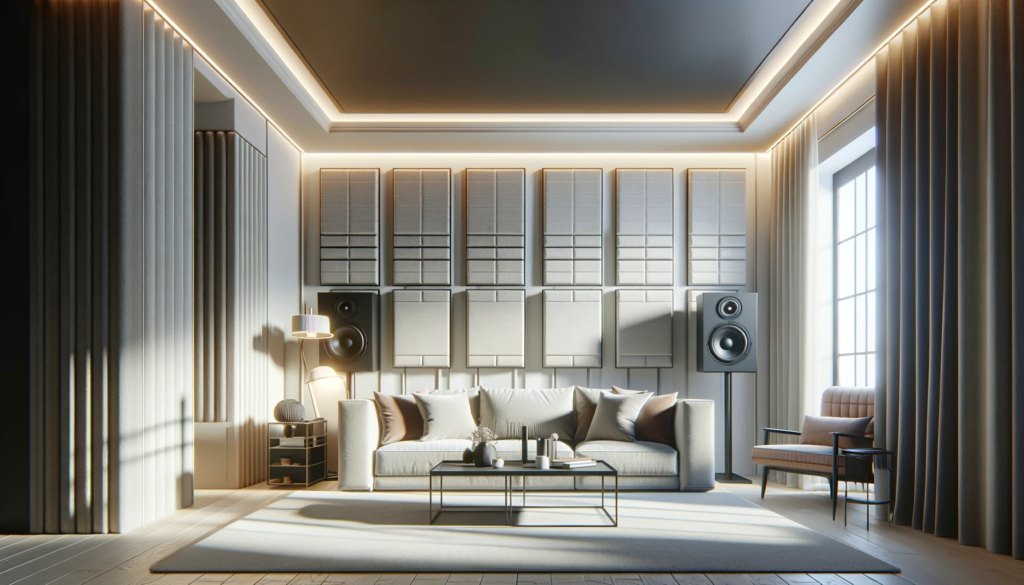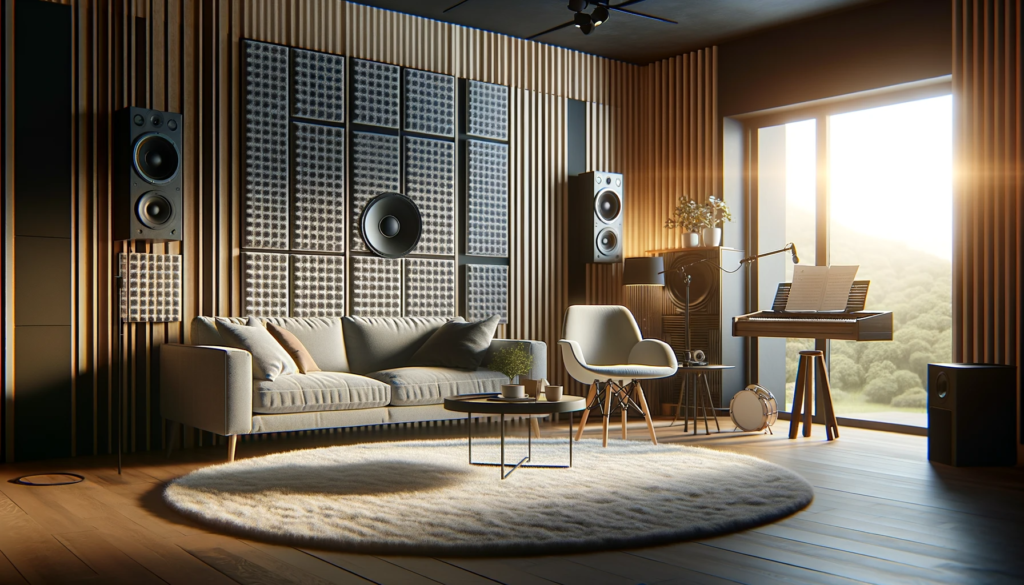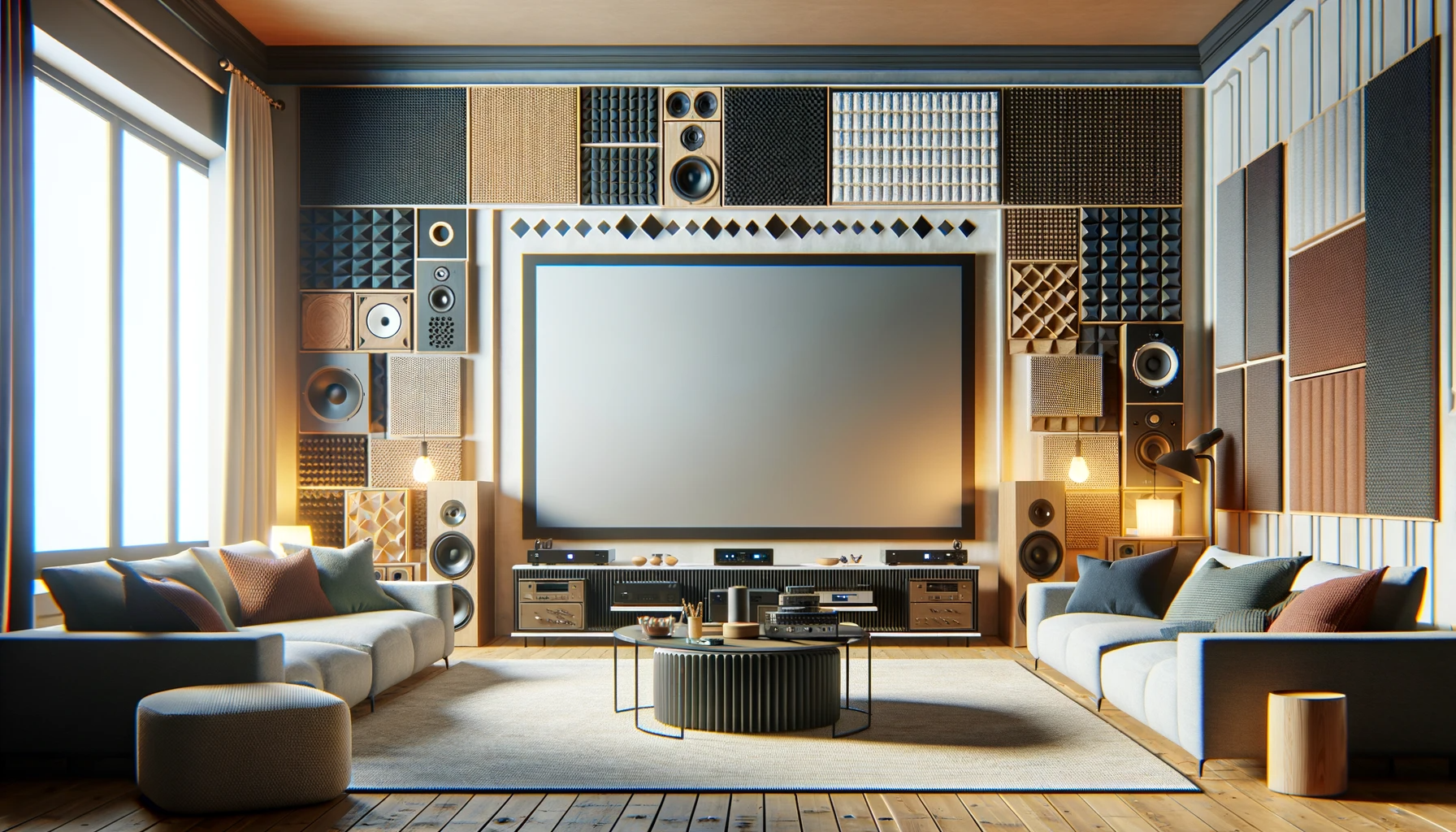Do you ever find yourself straining to hear a conversation at a bustling restaurant?
Or does your home theater sound boomy and muddled during action scenes?
The problem likely isn’t your hearing – it’s poor acoustics.
Acoustic panels offer an effective solution for taking control of any space’s sound issues.
By strategically placing materials to absorb, diffuse, and redirect sound waves, acoustic panels can optimize a room’s acoustics for clearer, tighter sound.
In this article, we’ll explore what acoustic panels are, how they work, the different types available, optimal placement strategies, top use cases, and why acoustic treatment is a worthwhile investment for creating an immersive listening environment.
Let’s dive into the world of acoustic panels and how they can transform your space.
What Are Acoustic Panels?

Acoustic panels, also known as acoustic treatment or sound absorbing panels, are materials installed in a room to absorb, diffuse, and redirect sound waves to improve the acoustics.
Acoustic panels are used to control excessive reverberation and echo that can make speech and music sound unintelligible and muddy in a space.
Thereby improve sound quality
Acoustic panels come in various shapes, sizes, thicknesses, and materials to suit different aesthetic and acoustic needs – for example, wooden acoustic panels can be perforated to make them a perforated acoustic panels known to help displace sound energy across the entire room to make them sound good.
Read more about how do perforated acoustic panels work here for more details.
They can also have different forms to it which make them a good wall accent or wall art when installed on walls.
Acoustic panels are manipulated (in a good way) making them looks good on installed walls – we also call them acoustic art panels.
When acoustic panels are installed on ceilings, they are sometimes called acoustic baffles or acoustic ceiling panels depending on who you are talking to.
When sound waves strike a bare hard surface like walls or floors, the sound energy is reflected back into the room causing reverberation buildup.
This absorption reduces excessive lingering reverberation and echo that degrades sound quality.
In addition to absorbent acoustic panels, diffusive panels are used to scatter sound reflections in a controlled way.
How Acoustic Panels Work to Absorb Sound

Acoustic panels work by using porous absorptive materials or resonating chambers to convert sound energy from sound waves into heat as the sound passes through.
Materials like fiberglass, mineral wool, and foam effectively absorb mid to high frequencies.
Panels tuned with Helmholtz resonators or diaphragmatic panels can also absorb lower bass frequencies.
Controlling Reverb and Echo
The combination of absorption and diffusion provided by acoustic panels alters the way sound propagates and reflects in a room to control issues like reverberation and echo to improve sound quality.
To know more if acoustic panels are effectiveness, check out posts here:
What to Consider When Choosing Acoustic Panels

Performance Factors
There are some important considerations when selecting acoustic panels.
Consider performance ratings indicating the sound frequencies absorbed based on intended use.
Look at placement to target specific noise issues instead of full coverage.
Appearance and Installation
There are appearance options to match room decor such as fabric colors and printed patterns.
Also factor installation needs like DIY vs professional mounting on particular wall types.
Choosing the right acoustic panels for your space and goals allows you to improve sound absorption, reduce noise, and enhance acoustic comfort.
Quantity Of Acoustic Panels You Need
The quantity of acoustic panels you need for your space is a very important factor that will affect if your project is a success.
While the ideal number of acoustic panels needed depends on several factors like room size, intended use, issues to address, and budget, as a general guideline here are the number of acoustic panels you need:
Small rooms need about 10 panels, medium rooms need around 20 panels, and large rooms require approximately 30 panels.
More specialized spaces like home theaters need 60 panels while recording studios need 40.
Carefully position panels using proven techniques like the 1/3 Rule for optimal acoustic treatment.
Overall, it’s crucial to calculate and place the right acoustic panel quantity for your particular room.
Read more here to know how many acoustic panels you exactly need for the size of your space
Cost Of Acoustic Panels
Before your acoustic treatment project starts, you should have an estimate on the budget that you can use for acoustic treatment vs.
the quantity of acoustic panels you need to have a better understanding.
Acoustic panels are expensive no doubt but here is a guide on understanding how much you need for an acoustic treatment project.
What Are The Best Uses of Acoustic Panels

Acoustic panels improve sound quality in many types of spaces.
Recording studios and critical listening rooms benefit from absorption and diffusion.
Home theaters rely on room damping to prevent dialog from getting washed out.
Conferencing and Presentation Spaces
Office absorption improves conferencing audio and reduces echoes.
Restaurants can reduce excessive ambient noise levels using panels.
Classrooms and auditoriums gain better speech intelligibility for students.
Providing Clear, Quality Sound
Optimized acoustics are valuable in spaces where sound quality, noise reduction, and clarity of speech matter.
The right acoustic panel solution can significantly enhance the listening experience.
Conclusion
Acoustic panels offer an effective way to take control of any space’s sound.
By strategically absorbing, diffusing, and redirecting sound waves, these treatments address core issues that degrade room acoustics.
Excessive lingering reverberation, bothersome distinct echoes, and problematic bass buildup can all be tamed with the right acoustic panels.
The result is a clearer, tighter, and more pleasant-sounding environment.
For those looking to optimize their auditory experience, acoustic panels are a worthwhile investment.
From home studios to offices, theaters to restaurants, the benefits of reduced noise and enhanced clarity make a real impact.
Thoughtfully placed and selected panels can be subtly integrated into existing decor as well.
With so many quality acoustic panel solutions available today, it is easier than ever to transform even difficult spaces into great-sounding rooms.
Your ears will thank you.
What Are Acoustic Panels Made Out Of?

Acoustic panels are typically constructed from sound-absorbing materials designed to improve the acoustics.
There are several common materials used in acoustic panels to help absorb or diffuse sound waves in order to reduce noise levels and improve sound quality.
Fiberglass is one of the most popular materials used in acoustic panels.
The fibrous texture helps absorb sound waves across a wide range of frequencies.
High density fiberglass acoustic panels provide excellent sound absorption and are commonly used in studios and theaters but some experts might say that they are not safe to be installed indoors, read to know if fiberglass acoustic panels are safe to use
Alternatively, rigid fiberboard acoustic panels offer a more durable and rigid acoustic solution, though they absorb less low-end frequency absorption compared to fiberglass acoustic panels.
However, the rigid surface allows for a more lightweight acoustic panel design.
Mineral wool is another common sound absorbing material used for its acoustic properties.
Mineral wool effectively absorbs sound while also being fire resistant.
Acoustic panels may also contain natural materials like cotton or polyester fiber fill as an eco-friendly way to absorb sound.
Read about if polyester acoustic panels are a good choice for acoustic panels.
In addition to absorbent acoustic panel cores, wooden diffuser panels help diffuse, scatter, and redirect sound reflections.
The angled wooden surface prevents distinct focused echoes.
Perforated metal can also be used to construct diffuser panels with controlled sound scattering.
The acoustic panels installed in a room can utilize different materials and combinations to target sound absorption, diffusion, redirection, and other acoustic goals to ultimately enhance the sound quality within the space.
Keen to learn how to make your own acoustic panels? Check out our guide on how to make your own acoustic panels
How to Use Acoustic Panels?

Acoustic panels can be used in many ways to improve the acoustics and sound quality within a space.
The panels are designed and constructed from sound-absorbing materials to absorb or diffuse sound waves, reducing reverberation, echo, and background noise.
There are several types of acoustic panels available on the market, such as fabric-wrapped panels filled with insulation to broadly absorb sound frequencies.
Diffuser panels made from wood or metal are used to scatter sound reflections whilst lowering the overall sound reflection in a spot.
Read about the difference between sound diffusers and acoustic panels
Corner bass traps target low frequencies.
Strategic placement of acoustic panels on walls, ceilings, and corners will help mitigate various sound issues.
Panels address early reflections, flutter echo, and other problems caused by hard, bare surfaces in a room.
The materials convert sound energy into heat rather than reflecting it back into the space.
Check out on how to use acoustic panels, bass traps to improve overall room acoustics
Installing the right acoustic panels reduces noise levels, enhances speech clarity, improves listening experiences, and creates a more balanced acoustic environment overall.
They block exterior noise from entering and interior noise from transmitting out.
With many options to choose from, select panels that suit your space’s specific acoustical needs and design aesthetic.
Carefully placing acoustic panels allows you to control sound in a finer way, customizing the room’s acoustics for clearer, better quality sound.
What Are the Benefits of Using Acoustic Panels?

There are several benefits to installing acoustic panels in a room.
They absorb excessive reverberation that causes echo and an overly live sound.
This improves speech clarity and music listening.
Bass trap panels help control low-frequency buildup that causes booming and muddiness.
Achieving Better Sound Quality
Proper acoustics allow you to achieve better sound quality from equipment.
Panels let you customize a room’s acoustics for different uses like studios or home theaters.
Acoustic panels effectively absorb sound waves and reduce sound levels.
Here is how acoustic panels are measured to see how effectiveness they are
Mitigating Background Noise
They can mitigate background noise and improve the overall acoustic environment.
Proper acoustic treatment with panels makes a world of difference in how good a room sounds.
They are worthwhile upgrades for any space where sound quality matters.
What Types of Acoustic Panels Are Available?

Lightweight Foam Panels
There are various materials and designs used in different types of acoustic panels to provide absorption, diffusion, and other acoustic properties:
Foam panels provide lightweight, inexpensive sound absorption.
The open-cell foam lightly absorbs mid-high frequencies but lacks bass control.
Foam panels can be a good starter acoustic treatment.
Read here to know if acoustic panels are safe before you make your purchase!
Broadband Absorbing Fabric Panels
Acoustic panels contain insulation inside an attractive outer covering to balance acoustics and aesthetics.
The insulation absorbs across frequencies for robust reverberation reduction.
On this topic, here is a perfect segway to how thick your acoustic panels should be?
Diffusing Wood and Metal Panels
Wood and metal diffuser panels are designed to scatter sound reflections instead of completely absorbing them.
This prevents focused echoes while retaining some reverb liveliness.
Targeted Bass Traps and Printed Panels
Corner bass traps use optimized insulation to absorb pooled low frequencies that cause booming resonances.
They target problematic bass buildup.
Printed acoustic panels combine decorative fabric coverings with inner sound absorption.
This allows them to enhance aesthetics while discretely improving acoustics.
Read more here on how to decorate your acoustic panels and if putting LED lighting behind acoustic panels will make acoustic panels dull?
Not sure which to buy? No worries! We’ve got the top 10 acoustic panels checked out to shorten your list.
You might notice that we did not list acoustic foam as a acoustic panels and that is because they are not.
Read on more here to know what difference they have and why you should choose acoustic panels over acoustic foam
How Do Acoustic Panels Absorb and Diffuse Sound?
Acoustic panels serve several purposes in tuning a room’s acoustics.
They absorb excessive sound reverberation and echo when sound hits the panel surface.
This reduces the buildup of lingering reflections.
Preventing Distinct Echoes
Diffusive panels scatter and redirect reflections to prevent distinct echoes.
This diffusion improves clarity.
Bass traps specifically target low-frequency buildup that can cause boomy resonances.
This tightens and cleans up the bass response.
Enhancing Listening Experiences
Overall, acoustic panels enhance the sound quality for better clarity and intelligibility.
They also allow customizing acoustics.
Properly installed acoustic panels absorb, diffuse, and redirect sound in ways that control key issues degrading room acoustics.
Treating these problems provides a clearer, tighter sound.
Myth About Acoustic Panels
Acoustic panels can definitely help you achieve better sound and mitigate backgroud noises making your space more peaceful and nice but they are a different thing from soundproofing.
Read on here as we debunk the differences between soundproofing and acoustic treatment
Where Should Acoustic Panels Be Installed?

Strategic acoustic panel placement targets specific sound issues.
Full ceiling coverage provides broad reverb absorption.
Front ceiling panels treat early reflections.
On walls, side wall panels reduce reverberation buildup over time.
Front wall reflection points widen the soundstage.
Corners and Rear Walls
In-room corners, and corner-mounted bass traps target low-frequency buildup right where it pools in the intersection.
For rear walls behind listeners, diffusers prevent problematic distinct reflections and substitute them with scattered reflections.
Addressing Problem Spots
Careful placement maximizes the acoustic benefits of panels.
Analyze the room and address key problem spots.
Where To Install Acoustic Panels In Different Settings?
Where to install acoustic panels in your space is a deep topic which we intend to cover them specifically, check out our guides below whichever suits you more about what you want to acheive:
How To Install Acoustic Panels?
After knowing where to install in each settings, how to install is equally important to have the full effects of the acoustic panels.
Here are some guides on how to properly install acoustic panels:
What to Consider When Choosing Acoustic Panels

Performance Factors
There are some important considerations when selecting acoustic panels.
Consider performance ratings indicating the sound frequencies absorbed based on intended use.
Look at placement to target specific noise issues instead of full coverage.
Appearance and Installation
There are appearance options to match room decor such as fabric colors and printed patterns.
Also factor installation needs like DIY vs professional mounting on particular wall types.
Choosing the right acoustic panels for your space and goals allows you to improve sound absorption, reduce noise, and enhance acoustic comfort.
Quantity Of Acoustic Panels You Need
The quantity of acoustic panels you need for your space is a very important factor that will affect if your project is a success.
While the ideal number of acoustic panels needed depends on several factors like room size, intended use, issues to address, and budget, as a general guideline here are the number of acoustic panels you need:
Small rooms need about 10 panels, medium rooms need around 20 panels, and large rooms require approximately 30 panels.
More specialized spaces like home theaters need 60 panels while recording studios need 40.
Carefully position panels using proven techniques like the 1/3 Rule for optimal acoustic treatment.
Overall, it’s crucial to calculate and place the right acoustic panel quantity for your particular room.
Read more here to know how many acoustic panels you exactly need for the size of your space
Cost Of Acoustic Panels
Before your acoustic treatment project starts, you should have an estimate on the budget that you can use for acoustic treatment vs.
the quantity of acoustic panels you need to have a better understanding.
Acoustic panels are expensive no doubt but here is a guide on understanding how much you need for an acoustic treatment project.
What Are The Best Uses of Acoustic Panels

Acoustic panels improve sound quality in many types of spaces.
Recording studios and critical listening rooms benefit from absorption and diffusion.
Home theaters rely on room damping to prevent dialog from getting washed out.
Conferencing and Presentation Spaces
Office absorption improves conferencing audio and reduces echoes.
Restaurants can reduce excessive ambient noise levels using panels.
Classrooms and auditoriums gain better speech intelligibility for students.
Providing Clear, Quality Sound
Optimized acoustics are valuable in spaces where sound quality, noise reduction, and clarity of speech matter.
The right acoustic panel solution can significantly enhance the listening experience.
Conclusion
Acoustic panels offer an effective way to take control of any space’s sound.
By strategically absorbing, diffusing, and redirecting sound waves, these treatments address core issues that degrade room acoustics.
Excessive lingering reverberation, bothersome distinct echoes, and problematic bass buildup can all be tamed with the right acoustic panels.
The result is a clearer, tighter, and more pleasant-sounding environment.
For those looking to optimize their auditory experience, acoustic panels are a worthwhile investment.
From home studios to offices, theaters to restaurants, the benefits of reduced noise and enhanced clarity make a real impact.
Thoughtfully placed and selected panels can be subtly integrated into existing decor as well.
With so many quality acoustic panel solutions available today, it is easier than ever to transform even difficult spaces into great-sounding rooms.
Your ears will thank you.
